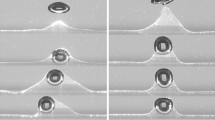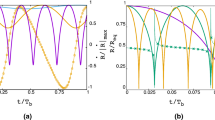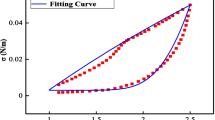Abstract
The influence of liquid viscoelasticity on the interaction between cavitation bubbles and free surfaces is of great practical significance in understanding bubble dynamics in biological systems. A series of millimeter cavitation bubbles were induced by laser near the free surfaces of the water and viscoelastic polyacrylamide (PAM) solutions with different concentrations. The effects of liquid viscoelasticity on the interactions of cavitation bubbles with free surfaces are analyzed from the perspectives of the evolution of free surface and bubble dynamics. The experimental results show that as the dimensionless standoff distance increases, the evolutions of free surface behaviors in all experimental fluids can be divided into six types of water mounds, i.e., breaking wrinkles, spraying water film, crown, swallowed water spike, hillock, and slight bulge. All the critical values of the dimensionless distance dividing different types decrease with increasing concentration. The evolutions of first four types of water mounds in PAM solutions differ from those in the water. Water droplets splashing in different directions are produced around the breaking wrinkles in the water. Meanwhile, the breaking wrinkles in PAM solution move with the “liquid filaments” towards the central axis. The water spike in the pattern of spraying water film in PAM solution is more stable than that in the water. As the solution concentration increases, the water skirt in the pattern of crown contracts earlier and faster, and the rate of increase in the height of the water skirt decreases. For swallowed water spike in PAM solution, the upper part of the newly formed water spike is not significantly thicker than the middle part, and thus the water waist structure does not form. Liquid viscoelasticity inhibits the bubble growth and collapse, and the bubble migration as well, especially in the second period. Shorter and thicker cavities are formed in PAM solutions with higher concentration, while slender and stable cavities formed in the water at the same dimensionless distance. The velocity and displacement of the tip of bullet jet both decrease as the solution concentration increases.
Similar content being viewed by others
References
Wang Y., Xu C., Wu X. et al. Ventilated cloud cavitating flow around a blunt body close to the free surface [J]. Physical Review Fluids, 2017, 2(8): 084303.
Yu C., Wang Y., Huang C. et al. Experimental and numerical investigation on cloud cavitating flow around an axisymmetric projectile near the wall with emphasis on the analysis of local cavity shedding [J]. Ocean Engineering, 2017, 140: 377–387.
Cheng S. H., Quan X. B., Zhang S. et al. Modeling tail bubble dynamics during the launch of an underwater vehicle using the boundary element method [J]. Journal of Hydrodynamics, 2022, 34(3): 434–443.
Xu C., Wang Y., Huang C. et al. Analysis of near-wall effect on cloud cavitating flow that surrounds an axisymmetric projectile using large eddy simulation with Cartesian cut-cell mesh method [J]. European Journal of Mechanics-B/Fluids, 2018, 67: 15–24.
Huang Y., Wang J., Abe A. et al. A theoretical model to estimate inactivation effects of OH radicals on marine Vibrio sp. in bubble-shock interaction [J]. Ultrasonics Sonochemistry, 2019, 55: 359–368.
Wang J. Z., Abe A., Koita T. et al. Study of sterilization effects on marine Vibrio sp. using interaction of cavitation with shock wave in a narrow water chamber [J]. Journal of Applied Physics, 2018, 124(21): 213301.
Wang J. Z., Abe A., Wang Y. W. et al. Fundamental study of sterilization effects on marine Vibrio sp. in a cylindrical water chamber with supply of only underwater shock waves [J]. Ultrasonics Sonochemistry, 2018, 42: 541–550.
Coussios C. C., Roy R. A. Applications of acoustics and cavitation to noninvasive therapy and drug delivery [J]. Annual Review of Fluid Mechanics, 2008, 40: 395–420.
Illing R. O., Kennedy J. E., Wu F. et al. The safety and feasibility of extracorporeal high-intensity focused ultrasound (HIFU) for the treatment of liver and kidney tumours in a Western population [J]. British Journal of Cancer, 2005, 93(8): 890–895.
Ter Haar G. HIFU tissue ablation: Concept and devices (Therapeutic ultrasound) [M]. Berlin, Germany: Springer, 2016, 3–20.
Kodama T., Takayama K. Dynamic behavior of bubbles during extracorporeal shock-wave lithotripsy [J]. Ultrasound Medicine and Biology, 1998, 24(5): 723–738.
Brujan E. A., Nahen K., Schmidt P. et al. Dynamics of laser-induced cavitation bubbles near elastic boundaries: Influence of the elastic modulus [J]. Journal of Fluid Mechanics, 2001, 433: 283–314.
Cho S. Y., Kwon O., Kim S. C. et al. Understanding cavitation-related mechanism of therapeutic ultrasound in the field of urology: Part I of therapeutic ultrasound in urology [J]. Investigative and Clinical Urology, 2022, 63(4): 385–393.
Lee T., Baac H. W., Ok J. G. et al. Nozzle-free liquid microjetting via homogeneous bubble nucleation [J]. Physical Review Applied, 2015, 3(4): 044007.
Kyriazis N., Koukouvinis P., Gavaises M. Numerical investigations on bubble-induced jetting and shock wave focusing: Application on a needle-free injection [J]. Proceedings of The Royal Society A Mathematical Physical and Engineering Sciences, 2019, 475(2222): 20180548.
Mur J., Agrez V., Petelin J. et al. Microbubble dynamics and jetting near tissue-phantom biointerfaces [J]. Biomedical Optics Express, 2022, 13(2): 1061–1069.
Gibson D. C. Cavitation adjacent to plane boundaries [C]. Third Australasian Conference on Hydraulics and Fluid Mechanics, Sydney, Australia, 1968.
Zhang S., Wang S. P., Zhang A. M. Experimental study on the interaction between the bubble and free surface using a high-voltage spark generator [J]. Physics of Fluids, 2016, 28(3): 032109.
Supponen O., Obreschkow D., Tinguely M. et al. Scaling laws for jets of single cavitation bubbles [J]. Journal of Fluid Mechanics, 2016, 802: 263–293.
Wang G. H., Du Y., Xiao Z. J. et al. Numerical study on formation of a splash sheet induced by an oscillating bubble in extreme vicinity to a water surface [J]. Journal of Hydrodynamics, 2022, 34(6): 1021–1031.
Rosselló J. M., Reese H., Ohl C. D. Dynamics of pulsed laser-induced cavities on a liquid-gas interface: From a conical splash to a ‘bullet’ jet [J]. Journal of Fluid Mechanics, 2022, 939: A35.
Kiyama A., Tagawa Y., Ando K. et al. Effects of a water hammer and cavitation on jet formation in a test tube [J]. Journal of Fluid Mechanics, 2016, 787: 224–236.
Chen R. C. C., Yu Y. T., Su K. W. et al. Exploration of water jet generated by Q-switched laser induced water breakdown with different depths beneath a flat free surface [J]. Optics Express, 2013, 21(1): 445–453.
Saade Y., Jalaal M., Prosperetti A. et al. Crown formation from a cavitating bubble close to a free surface [J]. Journal of Fluid Mechanics, 2021, 926: A5.
Zhang A. M., Cui P., Wang Y. Experiments on bubble dynamics between a free surface and a rigid wall [J]. Experiment Fluids, 2013, 54: 1602.
Brujan E. A., Vogel A. Stress wave emission and cavitation bubble dynamics by nanosecond optical breakdown in a tissue phantom [J]. Journal of Fluid Mechanics, 2006, 558: 281–308.
Acosta A. J., Parkin B. R. Cavitation inception-a selective review [J]. Journal of Ship Research, 1975, 19(4): 193–205.
Brujan E. A. Shock wave emission from laser-induced cavitation bubbles in polymer solutions [J]. Ultrasonics, 2008, 48(5): 423–426.
Brujan E. A., Ohl C. D., Lauterborn W. et al. Dynamics of laser-induced cavitation bubbles in polymer solutions [J]. Acta Acustica united with Acustica, 1996, 82(3): 423–430.
Lind S. J., Phillips T. N. The effect of viscoelasticity on the dynamics of gas bubbles near free surfaces [J]. Physics of Fluids, 2013, 25(2): 69–76.
Blake J. R., Gibson D. C. Growth and collapse of a vapour cavity near a free surface [J]. Journal of Fluid Mechanics, 1981, 111: 123–140.
He Z. B. Experimental study on dynamic of cavitation bubbles near elastic boundaries in viscoelastic fluids [D]. Harbin: Harbin Institute of Technology, Master thesis, 2021 (in Chinese).
Zhang A. M., Wang C., Wang S. P. et al. Experimental study of interaction between bubble and free surface [J]. Acta Physica Sinica, 2012, 61(8): 084701. (in Chinese)
Bhat P. P., Appathurai S., Harris M. T. et al. Formation of beads-on-a-string structures during break-up of viscoelastic filaments [J]. Nature Physics, 2010, 6(8): 625–631.
Reneker D. H., Yarin A. L., Zussman E. et al. Electros-pinning of nanofibers from polymer solutions and melts [J]. Advances in Applied Mechanics, 2007, 41(7): 43–195.
Li S., Zhang A. M., Wang S. P. Experimental and numerical studies on “crown” spike generated by a bubble near free-surface [J]. Acta Physica Sinica, 2013, 62(19): 194703. (in Chinese)
Williams P. R., Williams P. M., Brown S. W. J. A study of liquid jets formed by bubble collapse under shock waves in elastic and Newtonian liquids [J]. Journal of Non-Newtonian Fluid Mechanics, 1998, 76(1–3): 307–325.
Acknowledgement
This work was supported by the Natural Science Foundation of Heilongjiang Province of China (Grant No. LH2022E062).
Author information
Authors and Affiliations
Corresponding author
Ethics declarations
Conflict of interest: The authors declare that they have no conflict of interest. All authors declare that there are no other competing interests.
Ethical approval: This article does not contain any studies with human participants or animals performed by any of the authors.
Informed consent: Informed consent was obtained from all individual participants included in the study.
Additional information
Project supported by the National Natural Science Foundation of China (Grant No. 51806051).
Biography: Yang Liu (1992-), Female, Ph. D. Candidate
Rights and permissions
About this article
Cite this article
Liu, Y., Zheng, Zy., He, Zb. et al. Effect of liquid viscoelasticity on the interactions between cavitation bubbles and free surfaces. J Hydrodyn 35, 887–898 (2023). https://doi.org/10.1007/s42241-023-0064-5
Received:
Revised:
Accepted:
Published:
Issue Date:
DOI: https://doi.org/10.1007/s42241-023-0064-5




